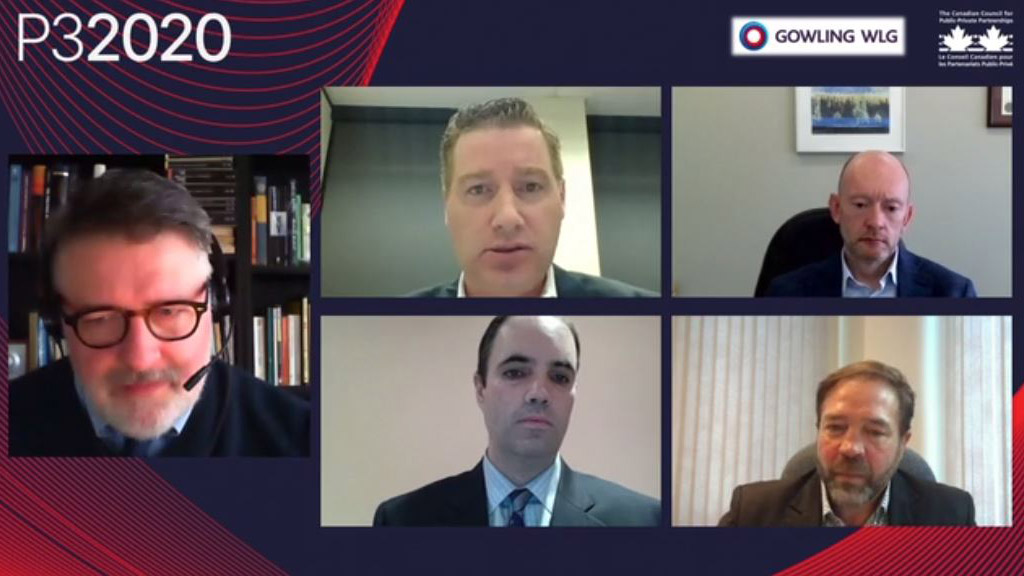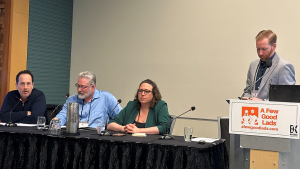Provincial infrastructure officials concurred at a recent virtual conference that public-private partnerships mean balancing local concerns, larger partnerships and leveraging experience from across the country.
Gowling WLG partner Thomas Timmins moderated the Canadian Infrastructure Procurement Agencies Tackle the Evolution of Infrastructure Delivery session at the Canadian Council for Public Private Partnerships (CCPPP) annual conference, held for the first time in a virtual setting.
Newfoundland and Labrador Deputy Minister of Transportation and Infrastructure Cory Grandy; Nova Scotia Department of Transportation and Infrastructure Renewal executive director Gary Porter; Alberta Infrastructure Assistant Deputy Minister Andy Ridge; and Assistant Deputy Minister of Infrastructure Development and SaskBuilds Miguel Morrissette all took a deep dive into the differences and similarities of each province’s approach to public-private partnerships (P3) for major capital projects.
Both Morrissette and Grandy cited relatively recent entry into use of the P3 model as a benefit to their respective provinces.
“SaskBuilds is a relatively new agency and we benefited from experience from across the country. We took experience from elsewhere and applied it to our model,” he said.
“We’ve done P3 vertical and civil infrastructure projects. For the Regina Bypass we used Infrastructure Ontario documents and models, and on vertical we used Projects BC models,” Morrissette added.
“We share in that iterative and evolutionary model,” Ridge agreed. “You’ll see sharing across Canada and that’s a good thing. There should also be some comfort from an international perspective that there are some commonalities (across Canada).”
Grandy indicated Newfoundland also uses prior experience while keeping in mind local needs.
“It’s important to us not to try to be too unique in our set of documents and approaches. We also built from the Projects BC template and used it as a jumping off point,” he said.
“One thing of note that we did with our health care infrastructure was address energy performance. We asked proponents to give us energy targets and then we filed that.”
Unique to the Newfoundland and Labrador approach was collaboration throughout the procurement period, Grandy added.
“We tried to be as interactive as possible with proponents while also being fair. We got good feedback from participants that they welcomed open dialogue,” he said.
All the panel participants concurred on the importance of both providing opportunities whenever possible for local firms while attracting larger companies and international investment for major projects.
“It’s something we took very seriously,” Porter said. “There’s consortium level interest and that’s not something we have locally. We want to partner with entities that have shown success in the past. We embarked on market soundings and consultations to see how we can attract that interest if it’s there, and we found quickly that is was.”
“The majority of our projects are delivered by local people (in Alberta) but we’re quite bullish at looking at international investment and partners to supplement that,” Ridge said.
Grandy said Newfoundland’s distance and size meant there was sometimes a need for outside investment.
“We’re to the far east of Canada and not always the easiest place to get to. Because of that it’s important we attract that attention from those larger partners you need for major infrastructure projects. When you’re talking hundreds of millions of dollars that’s too big for our local market,” Grandy said.
He added it’s important for local firms to benefit from projects and to that end the government partnered with local construction associations to ensure their participation.
“We’ve seen success from that very readily with relationships between major vendors and local builders. We’re also very happy with the fact that all contractors and sub-contractors recognize how important it is to promote local labour whenever possible,” he said.
Morrissette said large-scale projects can have a “legacy impact” and SaskBuilds is focused on how community benefits can be delivered for Indigenous communities and remote northern areas.
“We’re looking at how can we be more sensitive to those regions and use these projects as a lever for political outcomes we’re looking for such as increased apprenticeship opportunities for minority groups or increased local labour, developing local firms and having them engage on a local project,” he said.
Follow the author on Twitter @JOCFrey.











Recent Comments
comments for this post are closed